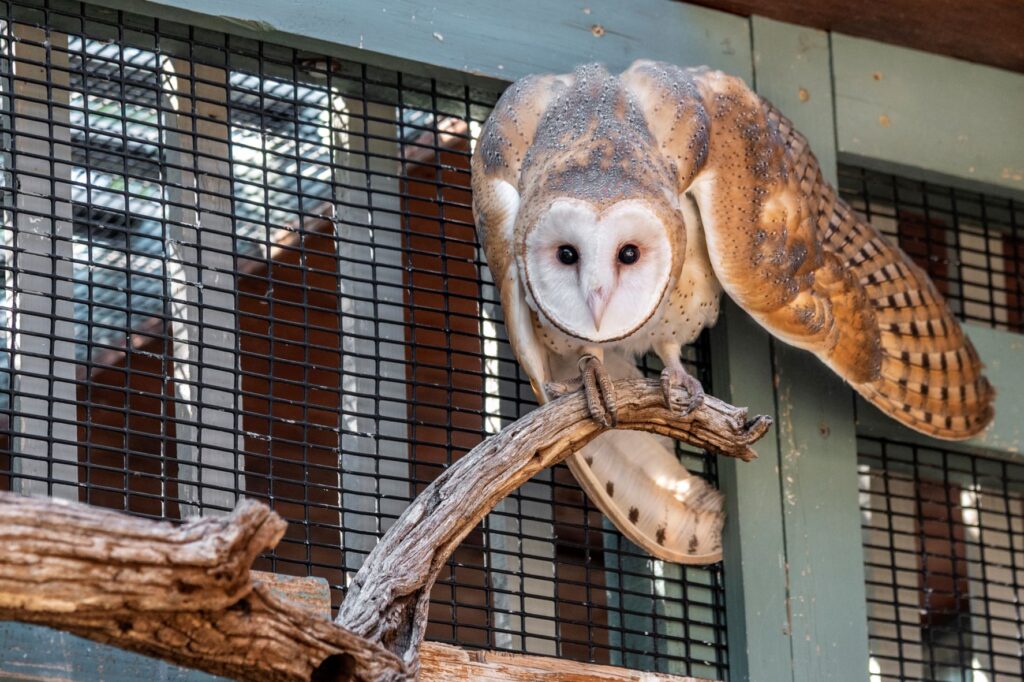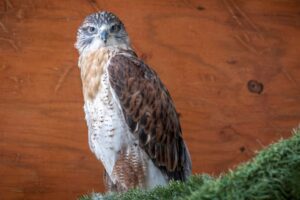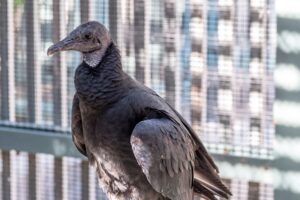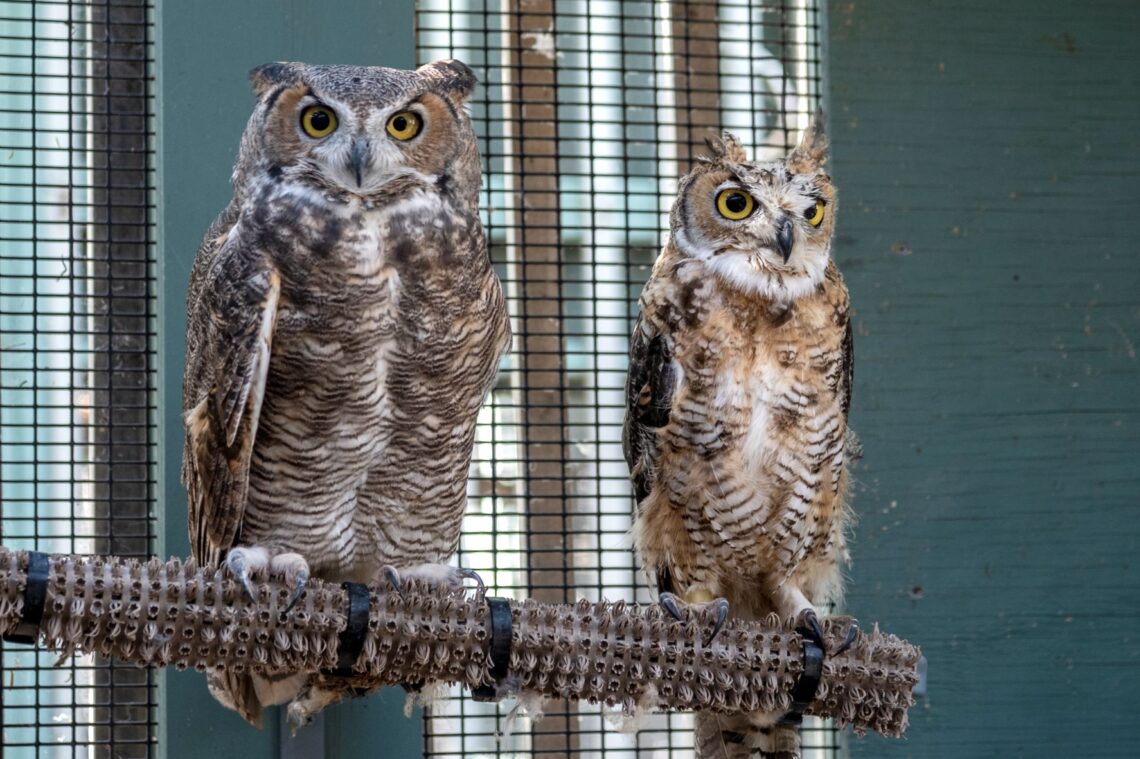Writer Joseph J. Airdo // Photography by Lorenz Crespo
More than 30 years ago, Bob and Sam Fox founded the Cave Creek-based nonprofit raptor rescue Wild at Heart on the wings of love.
“It really all starts with care and understanding,” Bob says.
That is a statement that can be applied to life itself as well as everything beneath the umbrella of it, but it is especially true of the work that is done at Wild at Heart.
The nonprofit organization got its name in part because barn owls — the first creatures for which it provided care — have a heart-shaped facial disc. However, it is also a nod to the fact that we are all essentially “wild at heart.”
“We all enjoy being out in the wild,” Bob explains. “We all enjoy seeing nature.”
But then there is also the fact that a lot of love, passion and heart goes into the rescue, rehabilitation and release of the more than 800 wild birds the nonprofit organization takes in each year.
It all stems from a desire to make life better — which may as well be the definition of love.
A Place for Owls



“We had been volunteering at the [Arizona Game and Fish Department’s Adobe Mountain Wildlife Center] and saw a need for something that extended beyond normal working hours,” Bob says.
That was in early 1990. It was also at that time Bob’s wife Sam read “A Place for Owls” by Kay McKeever, a well-known owl rehabilitator in Ontario, Canada who encouraged the use of non-releasable owls as surrogate parents for displaced owlets. Inspired by the author’s success, Sam requested permission to initiate a foster parenting program at the wildlife center as soon as a “suitable” bird was found.
The arrival of a severely ill, six-week-old barn owl with permanent wing and leg injuries provided Sam with just such an opportunity. After a long and arduous journey back to health, Bob built an aviary for the owl — which the couple named Chia — in the backyard of their former residence. In 1991, Chia raised his first group of 14 displaced nestlings, thereby becoming the avian forerunner of foster parenting in Arizona.
Of course, owls and most other wild birds cannot legally be kept as pets so, in order for Chia to remain with Bob and Sam, they needed to obtain special permits from the Arizona Game and Fish Department and the U.S. Fish and Wildlife Service. The couple did just that and officially founded Wild at Heart, incorporating their rehabilitation facility as a nonprofit organization and dedicating their lives to caring for the incredible creatures.
“We got immediately immersed,” Bob says. “The first year we took in about 150 birds.”
Thirty years later, Wild at Heart has expanded its care from exclusively barn owls to all other owls as well as hawks, falcons and eagles — most of which are brought in by its many dedicated volunteers. Moreover, its quantitative intake has increased exponentially.
“Last year, we took in 812 — one shy of our annual record,” says Bob, noting redtail hawks, Harris’ hawks and burrowing owls are among the many birds the facility sees. “Great horned owls have probably become the most common [birds] that come in. They are the most prolific of the raptors.”
The Circle of Life



The word “raptor” is derived from the Latin word “rapere” — which means “to seize.” Raptors are birds of prey that feed on live captured prey or on carrion.
Although Wild at Heart’s volunteers only pick up raptors, the facility temporarily cares for songbirds, quail, baby rabbits and other critters that are brought in by local residents until they can be transferred to other rehabilitators that specialize in those species.
Wild at Heart rescues, rehabilitates and releases raptors that have been injured or orphaned; relocates displaced burrowing owls; manages species recovery programs and habitat enhancement projects; and provides educational presentations to the community.
“We try to give the community an understanding of what each individual species is about, why they are valuable and what their role in the ecology is,” Bob explains. “It is just about understanding our role in the circle of life and the importance of each component. Everything has a need and a niche and is really valuable.”
Bob says that among the many things that Wild at Heart tries to impart with its educational presentations is the dangers that careless humans pose to not just raptors but other birds and animals — both wild and domestic.
“People tend to go for the easiest solution and put out poison when they have a rodent problem or something,” he explains.”That is just really not effective. It poisons such a small percentage of rodents but many of them are then consumed by other animals and they also get poisoned. Sticky traps are another thing. They are just so inhumane.”
Bob has seen it all. Wild at Heart treats poisonings, infections, electrocutions and injuries sustained by a bird being hit by a car or having flown into a window.
After three decades, Bob has also seen his fair share of raptors whose injuries are so traumatic that there is nothing Wild at Heart — or anyone else for that matter — can do to save them.
“Many of them that come in do not survive but we are at least able to provide them with a safe and comfortable environment to pass away,” Bob says. “A lot of people go to great lengths to rescue an injured animal only to have it come in and have to be euthanized. We try to make people feel positive about that experience, even though the end result is something that is negative.”
The Birds Come First



It is perhaps that experience and insight that prepared Bob for his own tragic loss last year when Sam passed away at age 73.
It has obviously been tremendously difficult, as Sam was the heart and soul of the nonprofit organization, but her husband says that he and the entire Wild at Heart team have remained focused on following her guidelines and philosophy: Do what is in the best interest of these magnificent birds.
“The birds come first,” Bob explains. “It is an honor to be able to do this work and to be able to treat these animals. The ability to heal them and get them back out into the wild is a great feeling. But it is also a feeling of responsibility to do the best that we can for them because they are an integral part of the ecosystem. There is a great need for them to be out there.”
Bob encourages the community to call Wild at Heart at 480-595-5047 for assistance with injured raptors. He also encourages donations to the nonprofit organization.
“It costs a little more than $600 per day just to feed the animals in our care,” he says. “We would not be here without the support of the community — the donors and the volunteers.”
Among the many gifts that Bob has received from his work with Wild at Heart is seeing first-hand just how caring wild creatures are.
“The fact that so many species will immediately and without question take on the care and feeding of orphans is an amazing thing,” he says. “That is really one of the main reasons that Wild at Heart got started. Such a simple thought was not that easy to accomplish but now we see that it happens so readily.”
That takeaway and the testament of love exhibited by feathered foster parents is just one more reason why Wild at Heart could not possibly have a more appropriate name than the one that Bob and Sam conceived more than three decades ago.







Comments by Admin